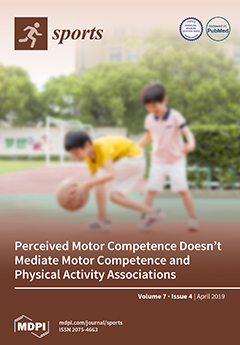The aim of this study was to examine the relationship of age and body mass status with field and laboratory measures of physical fitness in futsal players. Futsal players (
n = 65, age 12.9 ± 2.8 years), who were classified into U11
[...] Read more.
The aim of this study was to examine the relationship of age and body mass status with field and laboratory measures of physical fitness in futsal players. Futsal players (
n = 65, age 12.9 ± 2.8 years), who were classified into U11 (
n = 28, 9–11 years), U13 (
n = 21, 11–13 years), and adults (
n = 16, >18 years), performed a physical fitness battery consisting of both laboratory and field tests. A similar prevalence of overweight (25%) was observed in all age groups (χ
2 = 1.94,
p = 0.380, φ = 0.17). Age groups differed for all parameters, except body fat percentage, with adult players showing higher values than the younger groups (
p < 0.05). U13 was heavier, taller, and had larger fat-free mass than U11 (
p < 0.05). Adult players had superior values than their younger counterparts for all physical fitness parameters (
p < 0.05). Body mass index (BMI) correlated inversely with aerobic capacity (U13), jumping ability, relative isometric muscle strength, and relative mean power in the Wingate anaerobic test (WAnT) (U11) (
p < 0.05). Also, it correlated directly with absolute isometric muscle strength (U11) and peak power, mean power (all groups), and fatigue index (U11, U13) in WAnT (
p < 0.05). Considering the results of this study, it was concluded that the prevalence of overweight in futsal players should be an important concern for practitioners working in this team sport. Optimizing BMI should be considered as a training and nutrition goal in order to improve sport performance.
Full article






